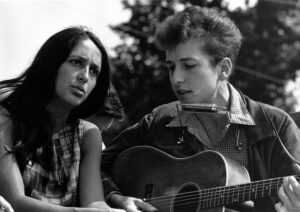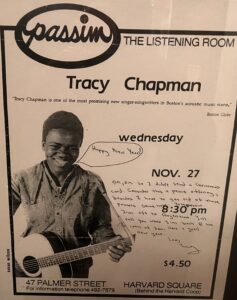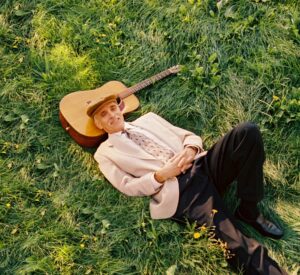By Colin McCandless
Contributing Writer
CAMBRIDGE – Located in the heart of Harvard Square in Cambridge, the legendary folk music venue Club Passim has been a mainstay of the New England arts community, hosting shows for more than 60 years and counting.
Established as Club 47 in 1958, Club Passim has existed as several different entities over the decades. Its original location was at 47 Mount Auburn St., where it first opened as a restaurant and jazz venue.
Shift to folk music
In what must be one of the more bizarre laws ever recorded on the books, the police initially closed Club 47 because it was illegal to have more than three stringed instruments in a restaurant while also serving drinks. To comply with the law, it reopened as a private club requiring a membership fee, explained Club Passim managing director Matt Smith, who has worked there since 1995. Smith started as a volunteer and later worked as performance manager, club manager and assistant manager before assuming his current role as managing director.
The focus then shifted to folk music. Performers who played there in the early days include luminaries who were then just starting their professional careers such as Joan Baez and Bob Dylan. Artists like Ramblin’ Jack Elliot and Judy Collins were also part of that vibrant American folk music scene who graced the stage at Club 47 during its formative years. As a local living in Boston at the time, Baez played the club regularly. While Dylan participated in hootenannies and open mic sessions, he never played an actual billed concert there, according to Smith.

Photo/Wikimedia Commons/Rowland Scherman
The club moved to its current location, 47 Palmer St., in fall 1963. It closed in 1968 and later reopened as Passim in 1969. Although it was a café and card shop, because of Club 47’s iconic status as a folk music venue, people often stopped in and asked what happened to the music, said Smith.
The new owners, Bob Donlin and his wife Rae Ann, were beat poets who were friends with pioneering creatives of the Beat Generation such as the novelist and poet Jack Kerouac. “So he had sort of an artistic bent to him,” said Smith. It wasn’t long before patrons convinced him to expand into offering live music and ultimately folk tunes and the singer-songwriter returned as a staple to Passim.
Rebirth in 1990s
The venue then closed again in 1994, at a time when folk music was experiencing a decline in popularity, noted Smith. Yet by this point the club was well-known and had supported countless amazing artists throughout its history who had gone on to achieve fame and fortune. In the 1970s, Passim hosted musicians like Tom Waits, Jackson Browne and Stevie Nicks before she joined Fleetwood Mac. Grammy award-winning singer-songwriter Tracy Chapman played there in the 1980s. An independent record label named Rounder Records (that was based in Cambridge at the time) stepped in to save Passim, putting up an interest-free loan to pay off the establishment’s debts and help incorporate it as a nonprofit. It reopened once again in 1995, this time as Club Passim.

In more recent years, Passim has featured artists like Josh Ritter and Regina Spektor.
Smith said that the raison d’etre of Passim and its concert space is to serve as an incubator. “It’s a place where people start to learn their craft.” The tiny, intimate venue only has a capacity of 110 seats. “The seating goes right up to the stage,” related Smith. “There’s not distance between the performer and the audience.”
He added that Passim is intended as a listening room that is not for idle conversation. “It’s almost like a small theater,” Smith elaborated. “People aren’t coming to the concert and standing and talking to each other the whole time. You’re there for the show. And the artist is driving the bus. And you’re along for the ride. They’re (the audience) part of the show.”
Although most associated with folk music, Smith qualified of Passim, “It’s that and a lot more. It’s more about the way we present music as opposed to the specific genre that’s on stage.”
A diversity of genres today
Today, the all-ages club showcases music covering a broad range of musical genres including Americana, bluegrass, blues, Celtic, country, folk, jazz, klezmer, old-time, pop/rock, singer-songwriter, a cappella, hip hop, world music and more.
“It’s all kinds of genres,” remarked Smith. “But it’s more about the kind of space and the interaction you have.”
The Noise Magazine once described the experience of catching a show at Passim this way: “Seeing live music in Passim is similar to having a band in your own living room: the throbbing beat surrounds the crypt-like club and makes the performance seem almost interactive between the group/audience. The feeling is so intense that the listener is swept up in the atmosphere and becomes part of the event.”
Remarkably, some artists have continuously played at Passim since the 1960s.
“Because it is that place that is part of their origin story,” mused Smith. One example is Jim Kweskin, 84, a folk musician best known for forming the Jim Kweskin Jug Band in the early 1960s. He first began performing at Passim when he was in his 20s. Kweskin has kept up with music his entire life and released a new album in January.

Passim hosts festivals such as BCM Fest, a Celtic music festival held in January, as well as a bluegrass festival in April. This year will also mark the 26th year of its Campfire Festival, presented on both Memorial Day and Labor Day weekends. Smith described this sonic sampler as an “all-you-can-eat buffet of music over four days.”
Creating a music community
As a nonprofit, part of Passim’s mission is to create and encourage a vibrant music community, and in 1999 they established a School of Music that offers classes. It mostly consists of group classes typically arranged in ensembles with varied styles or genres during which people of all different instruments perform together.
Additionally, it offers various grant programs. Passim developed its first grant initiative, the Iguana Music Fund, in 2008. Since then it has gone on to establish other grant projects including the Gecko Fund and the Brian O’Donovan Legacy Fund, named after the late Celtic radio personality and presenter to honor the contributions he made to Passim and Boston’s Celtic music community. During the COVID-19 pandemic, it launched a grant program called the PEAR (Passim Emergency Artist Relief) Fund to raise money to provide financial assistance to out of work musicians.
As a nonprofit club, it offers memberships with annual dues at varying levels depending on affordability. Members receive discounts, early tickets to upcoming concerts and opportunities to attend free member events. “They become a really big part of what keeps this engine running and are a big part of the way artists get their start. So they’re kind of boosters for the arts,” asserted Smith.
To check out upcoming shows and festivals or to donate or buy a membership, visit passim.org.
RELATED CONTENT:
Boston’s legendary rock club ‘The Rat’ is still remembered fondly
The Channel nightclub was one of Boston’s top live music spots in the ’80s
Worcester’s El Morocco restaurant and nightclub drew stars from near and far












